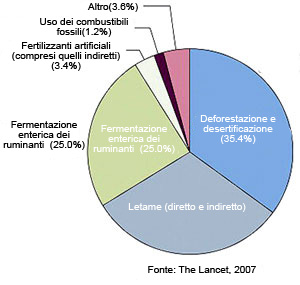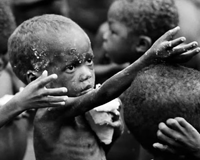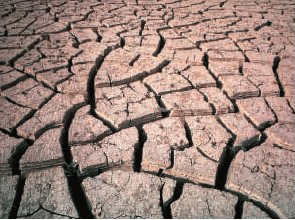Main Climate Change Solution - Veganism
 Supreme Master Ching Hai - a world-renowned spiritual teacher, artist, and humanitarian
Supreme Master Ching Hai - a world-renowned spiritual teacher, artist, and humanitarian
"The root of our problem is that we have been unkind to our co-inhabitants: the living, feeling, walking, acting, loving beings, like animals, of all size and shapes. And we have also been unkind to our environment. We have been massacring our co-inhabitant animals, and we have been destroying our environment, like deforesting and destroying the water and destroying the air. So, in order to solve the problem that we are facing right now, we have to reverse our actions. We have to be kind to our co-inhabitants. Instead of killing them, massacring them, sacrificing them, we have to take care of them. And instead of deforestation, we have to plant trees again. Take care of whatever environment that we have." Tutti i collegamenti relazionati
 Dr. James Hansen - NASA's top climatologist
Dr. James Hansen - NASA's top climatologist
"There are many things that people can do to reduce their carbon emissions, but changing your light bulb and many of the things are much less effective than changing your diet, because if you eat further down on the food chain rather than animals, which have produced many greenhouse gases, and used much energy in the process of growing that meat, you can actually make a bigger contribution in that way than just about anything. So, that, in terms of individual action, is perhaps the best thing you can do."
"My message to you is: Be Veg, Go Green, Save the Planet."  Mostra il filmato |
Mostra il filmato |  Nascondi il filmato
Nascondi il filmato
L'impatto della produzione e del consumo di carne sul cambiamento climatico
 La Carne e il Cambiamento Climatico
La Carne e il Cambiamento Climatico
- Secondo il rapporto dell’IPCC dell’ONU “La lunga ombra del bestiame”, gli allevamenti di bestiame sono la causa principale del riscaldamento globale.
- I rifiuti animali e i foraggi dei campi gettano più agenti inquinanti nei flussi d’acqua rispetto a tutte le altre attività umane messe insieme.
- Le alimentazioni a base di carne richiedono 10 – 20 volte più terreno rispetto a quelle a base di vegetali – quasi la metà della produzione mondiale di soia e cereali è usata come foraggio per gli animali.
|

Proporzioni di emissioni di Gas Serra in diverse fasi della produzione di bestiame |
Emissioni dalla produzione di bestiame: 18%
Emissioni dei trasporti globali: 13.5%
il 18% di tutte le emissioni di gas serra dalle attività umane comprende:
9% di CO2
37% di CH4(metano) – 23 volte più potente del CO2 su un periodo di 100 anni, 72 volte più potente su un periodo di 20 anni
65% di N2O (ossido d’azoto) – 296 volte più potente del CO2 su un periodo di 100 anni, 275 volte su un periodo di 20 anni
Fonte: FAO, 2006 (1) |
|
La produzione di 1 kg di manzo:
- Emette gas serra con un potenziale di riscaldamento equivalente a 36.4 kg di CO2 .
- Rilascia fertilizzanti equivalenti a 340 gr di biossido di zolfo e 59 gr di fosfati
Consuma 169 megajoules di energia .
- 1 kg di manzo è responsabile della quantità equivalente di CO2 emessa da un’auto media europea ogni 250 km e brucia l’energia sufficiente ad illuminare una lampadina da 100 watt per 20 giorni .
- Oltre due terzi di energia vengono usati per la produzione e il trasporto dei foraggi.
Fonte: Animal Science Journal, 2007 |
" lo strato del permafrost si scioglie ogni giorno. E il gas metano o anche altri gas vengono rilasciati nell’atmosfera. Spero davvero e prego che qualcuno ascolti. Il metano e l’ossido nitroso, sono prodotti dall’allevamento del bestiame.
A causa dell’atmosfera che si riscalda sempre di più il metano risale. Se fermiamo la causa principale del riscaldamento globale, l’allevamento degli animali, potremo salvare il pianeta. Dobbiamo fermare l’uccisione di uomini o animali. Dobbiamo smettere di produrre derivati animali. E dobbiamo smettere di usarli ".
- Somma Maestra Ching Hai - 6 luglio 2008– Conferenza di Londra (2)
| |
 Deforestazione
Deforestazione

|
La deforestazione ha una forte importanza nel cambiamento climatico. Più di 300 esperti hanno affermato: “Se perdiamo le foreste, perdiamo la lotta contro il cambiamento climatico”. Ma la deforestazione amazzonica aumenta del 69% a causa della domanda di carne durante agosto 2007 e agosto 2008. Il settore è del bestiame è senza dubbio il maggiore singolo fattore di uso della terra a causa dell’uomo
- La produzione di bestiame abbatte il 70% di tutte le terre agricole e il 30% della superficie del mondo
- Il 70% dell’Amazzonia una volta coperta dalle foreste è occupata da pascoli per il bestiame e i campi coltivati per mangime per animali coprono gran parte di quanto rimane
- Il 20% del terreno da pascolo è degradato a causa di sovrappascolo, compattazione ed erosione
Fonte: FAO, 2006; Goodland R. et al,1999 |
" Tutto c’è per qualcosa. Come gli alberi, ci sono per dare ossigeno al pianeta. Senza alberi, moriamo. Davvero, moriremo. Moriamo senz’alberi. Ci sarà meno acqua, perché non ci saranno alberi per attrarre acqua e mantenere l’acqua quando c’è.
Quindi, tutto su questo pianeta, compresi noi, è inter-relato e aiuta reciprocamente a rendere le nostre vite confortevoli e vivibili, confortevoli. Ma se non lo sappiamo ci stiamo uccidendo, stiamo uccidendo noi stessi. Ogni volta che uccidiamo un albero, o uccidiamo un animale, uccidiamo una parte di noi stessi”.
- Somma Maestra Ching Hai - 6 giugno 2001- Florida, Stati Uniti
|
 Scarsità alimentare
Scarsità alimentare
 L’aumento dei prezzi del cibo ha spinto altri 75 milioni di persone sotto la soglia della fame, portando la stima delle persone malnutrite in tutto il mondo a 923 milioni nel 2007.(1) L’aumento dei prezzi del cibo ha spinto altri 75 milioni di persone sotto la soglia della fame, portando la stima delle persone malnutrite in tutto il mondo a 923 milioni nel 2007.(1)
Ma davvero il cibo è così scarso?
1/3 del raccolto dei cereali del mondo e oltre il 90% della soia viene usato come mangime per animali, malgrado l’inefficienza connessa. I cereali attualmente usati per alimentare il bestiame basterebbero ad alimentare 2 miliardi di persone.
Ci vogliono 10 kg di foraggio per produrre 1 kg di manzo
da 4 a 5 kg di grano per produrre 1 kg di maiale
da 2.1 a 3 kg di grano per produrre 1 kg di pollame
Fonte: FAO, 2006; CAST 1999; B. Parmentier, 2007
"Per tutto il resto ci vuole più tempo e non ne abbiamo. Quindi dobbiamo scegliere l’alimentazione vegetariana. Scegliere l’agricoltura biologica, aiutarci reciprocamente, condividere il cibo che abbiamo.
Perché se siamo vegetariani, tutti, avremo così tanto cibo da dividere con tutti; nessuno andrà più a letto affamato. E così avremo risparmiato molto tempo, energia, soldi per aiutarli anche ad affrontare le malattie e ricostruire le loro vite. Tutto è possibile, perché non ci saranno più guerre, neanche con gli animali. La pace comincia a casa".
- 2008 Momenti critici per salvare il pianeta: Cosa posso fare? Seminario – 29 giugno 2008(2) |
 Scarsità e inquinamento dell'acqua
Scarsità e inquinamento dell'acqua
 We are seeing severe drought with cracking lands, followed by massive flooding and destruction of agricultural products and other properties in an unprecedented scale.and every day, 30,000 children in the world die from diseases linked to water. (1) We are seeing severe drought with cracking lands, followed by massive flooding and destruction of agricultural products and other properties in an unprecedented scale.and every day, 30,000 children in the world die from diseases linked to water. (1)
70% of all water goes to producing food(3) and livestock is among the largest sectoral source of water pollution and responsible for 64% of ammonia emissions, which contribute to acid rain.
One factory farm creates more water pollution than the city of Houston, Texas.(4)
4664 liters of water to produce 1serving of beef but entire vegan meal need only 371 liters water.(5) Scientists have calculated that we would actually save more water by forgoing one pound of beef, or four hamburgers, than by not showering for at least six months (6)
"Yes. And a vegetarian diet will stop 80% of global warming, stop all the cruelty, beginning on our plate. Generating loving, kind energy around the world, stop water shortage and water pollution, stop food shortages, stop world hunger and war, prevent deadly diseases, save enormous tax and medical bills to build a better world, and support new useful inventions and good people’s organizations."
- An Interview with Supreme Master Ching Hai by James Bean of Spiritual Awakening Radio -July 29, 2008 - USA (7) |
 La sovrappesca e le aree morte
La sovrappesca e le aree morte
Fish fed to farmed animals threaten the ocean’s ecosystem and One-third of world fish catch used for animal feed. The results of a nine-year study by the Institute for Ocean Conservation Science at Stony Brook University and the University of British Columbia found that an alarming 28 million tons of ocean fish are currently being ground up and fed to factory-farmed fish, pigs and chickens.
Dr. Ellen K. Pikitch of Stony Brook University stated, “…It’s an enormous percentage of the world’s fish catch. Skyrocketing pressure on small wild fishes may be putting entire marine food webs at great risk.”
A report by the US-based research and education organization World Policy Institute stated that expanded fishing practices has created a perilous situation for ocean life. A 2003 study showed that 90 percent of the large fish in the oceans had disappeared in the previous 50 years, and the World Policy Institute is now calling for the monies spent on subsidies to the fishing industries to instead be used to create large marine reserves.
The ocean is acidifying from absorbing too much carbon dioxide, and warm temperatures force animals into new habitats. So-called “dead zones” devoid of life can be found spanning areas as large as tens of thousands of square miles. These are caused by both pollution and overfishing.
The United Nations Food and Agriculture Organization has reported that up to 80 percent of fished species are now on their way to extinction.
" Fish eating is also very depleting to planetary ecosystem. They have proven that overfishing of sardines has resulted in many dead zones. Because they are there for some reason. They are there for maybe oxidizing the ocean, give life to some other kind of species or cleaning the environment. Whatever the species that God has left on the planet, they have work to do. Just like humans, we have work to do. Animals, they have work to do. It's just many humans think they're useless so they fish them up and eat them. But they're very, very useful to our ecosystem."
Supreme Master Ching Hai - Videoconference with Hamburg Center, Germany – July 18, 2008
|
 Le malattie legate alla carne
Le malattie legate alla carne
ALCUNE MALATTIE LEGATE AL CONSUMO DI CARNE
- Malattia della lingua blu
- E. coli
- Salmonellosi
- Influenza aviaria
- Malattia della Vacca pazza
- Malattia del maiale(PMWS)
- Listeriosi
- Avvelenamenti da molluschi
- Pre-eclampsia
- Campylobacter
I COSTI DEL CONSUMO DI CARNE:
MALATTIE AL CUORE
- Oltre 17 milioni di vita perse ogni anni
- Costi delle malattie cardiovascolari: almeno 1 trilione di dollari all’anno
CANCRO
- Oltre 1 milione di pazienti di cancro al colon ogni anno.
- Oltre 600 000 decessi legati al cancro al colon.
- Solo negli Stati Uniti il cancro al colon costa circa 6.5 miliardi di dollari.
- Milioni di persone a cui è diagnosticato il cancro in relazione alla carne ogni anno.
DIABETE
- 246 milioni di persone sono colpite nel mondo
- Circa 174 miliardi di dollari spesi in trattamenti.
OBESITÀ
- Oltre 1.6 miliardi di adulti sono in sovrappeso con 400 milioni in più di obesi
- Costano 93 miliardi di dollari all’anno in spese mediche solo negli Stati Uniti.
- Almeno 2.6 milioni di persone muoiono ogni anno per problemi legati al sovrappeso o all’obesità.
ALTRO ANCORA…
|
 Risorse
Risorse
 |
Assessing The Environmental Impacts of Consumption and Production (2010) |
| - UNEP |
 |
The health benefi ts of tackling climate change - An Executive Summary for The Lancet Series |
| - The Lancet |
 |
Livestock and Climate Change |
| - Worldwatch Institute |
 |
Organic: A Climate Saviour? |
| - the Institute for Ecological Economy Research (IÖW) |
 |
Livestock Consumption and Climate Change: A Framework for Dialogue |
| - Food Ethics Council (FEC) as part of WWF’s One Planet Food programme |
 |
Slaughtering the Amazon |
| - Greenpeace |
 |
Cool Farming:Climate impacts of agriculture and mitigation potential (2008) |
| - Greenpeace |
 |
Climate benefits of changing diet (Free Preview - 2009) |
| - Elke Stehfest , Lex Bouwman, Detlef P. van Vuuren, Michel G. J. den Elzen, Bas Eickhout and Pavel Kabat |
 |
Food-Miles and the Relative Climate Impacts of Food Choices in the United States (2008) |
| - Carnegie Mellon University |
 |
Putting Meat on The Table: Industrial Farm Animal Production in America (2008) |
| - Executive Summary , Pew Commission on Industrial Farm Animal Production |
 |
American Meat: A Threat to Your Health and to the Environment (2004) |
| - Polly Walker,M.D.,M.P.H.&Robert S. Lawrence,M.D. |
 |
Happier Meals: Rethinking the Global Meat Industry. (2005) |
| - Worldwatch Paper 171 |
 |
Meat's Carbon Hoofprint (2007) |
| - Prof Barry Brook and Geoff Russell |
 |
The Economic Impact of Global Warming on Livestock Husbandry in Kenya (2008) |
| - Jane Kabubo-Marian,PhD School of Economics,University of Nairobi |
 |
Livestock's Long Shadow (2007) |
| - United Nations Food and Agriculture Organization |
 |
The livestock industry and climate (2007) |
| - Jens Holm & Toivo Jokkala |
 |
Cooking up a storm: Food, greenhouse gas emissions and our changing climate (2008) |
| - Food Climate Research Network |
 |
Saving Water: From Field to Fork - Curbing losses and wastage in the food chain (2008) |
| - Stockholm International Water Institute, International Water Management Institute, Chalmers, and Stockholm Environment Institute. |
 |
Can Britain Feed Itself? -Simon Fairlie( 2007) |
| - The Land |
 |
The Cattle Realm: A new phase in the livestock colonization of Brazilian Amazonia (2008) |
| - Amlgos da Terra |
|
|
Tutti i collegamenti relazionati
Informazioni pubbliche sul cambiamento climatico
 Supreme Master Ching Hai - a world-renowned spiritual teacher, artist, and humanitarian
Supreme Master Ching Hai - a world-renowned spiritual teacher, artist, and humanitarian  Dr. James Hansen - NASA's top climatologist
Dr. James Hansen - NASA's top climatologist ![]() Mostra il filmato |
Mostra il filmato | ![]() Nascondi il filmato
Nascondi il filmato Dr. Rajendra Pachauri - The chairman of the Intergovernmental Panel on Climate Change (IPCC)
Dr. Rajendra Pachauri - The chairman of the Intergovernmental Panel on Climate Change (IPCC) ![]() Mostra il filmato |
Mostra il filmato | ![]() Nascondi il filmato
Nascondi il filmato La Carne e il Cambiamento Climatico
La Carne e il Cambiamento Climatico Deforestazione
Deforestazione Scarsità alimentare
Scarsità alimentare Scarsità e inquinamento dell'acqua
Scarsità e inquinamento dell'acqua La sovrappesca e le aree morte
La sovrappesca e le aree morte Le malattie legate alla carne
Le malattie legate alla carne Risorse
Risorse


 L’aumento dei prezzi del cibo ha spinto altri 75 milioni di persone sotto la soglia della fame, portando la stima delle persone malnutrite in tutto il mondo a 923 milioni nel 2007.
L’aumento dei prezzi del cibo ha spinto altri 75 milioni di persone sotto la soglia della fame, portando la stima delle persone malnutrite in tutto il mondo a 923 milioni nel 2007. We are seeing severe drought with cracking lands, followed by massive flooding and destruction of agricultural products and other properties in an unprecedented scale.and every day, 30,000 children in the world die from diseases linked to water.
We are seeing severe drought with cracking lands, followed by massive flooding and destruction of agricultural products and other properties in an unprecedented scale.and every day, 30,000 children in the world die from diseases linked to water.